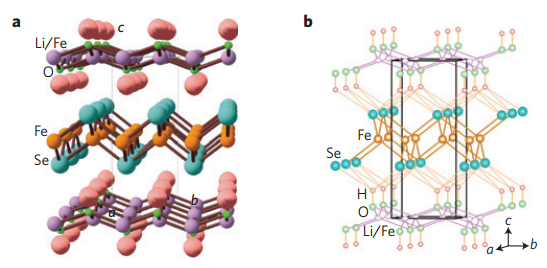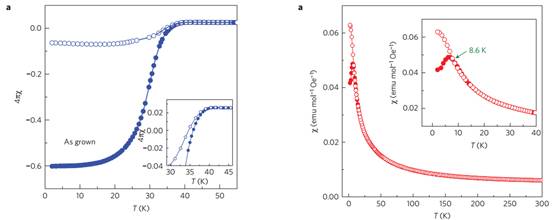An air stable and easily accessible FeSe-based superconductor (Li0.8Fe0.2)OHFeSe, whose superconducting at high temperature up to 40Kcoexistswith antiferromagnetic property, was fabricated by Prof. CHEN Xianhui’s group from USTC.
Tremendous experiments have suggested that FeSe-derived superconductors are good systems to investigate the mechanism of high-Tc superconductivity in iron-based superconductors. But one problem for the iron pnictidesis their extreme sensitivity to air, which prevents numerous feasible physical property measurements on these materials.

Crystal structure of (Li0.8Fe0.2)OHFeSe
With a novel hydrothermal method, Prof. CHEN’s group successfully synthesized a new FeSe-derived superconductor, (Li0.8Fe0.2)OHFeSe, with a Tc of ~40K. Using a combination of powder X-ray diifraction (XRD), neutron powder diffraction(NPD) and nuclear magnetic resonance (NMR), the structure of (Li0.8Fe0.2)OHFeSe was unambiguously determined. With alternate stacking of (Li0.8Fe0.2)OH layers and anti-PbO type FeSe layers, there exists a weak hydrogen bonding interaction between the layers. In comparison with β-Fe1+δSe, the FeSe4 tetrahedron is extremely compressed in the ab plane in (Li0.8Fe0.2)OHFeSe. Such a distorted FeSe4 tetrahedron is likely to play a key structural role in enhancing the superconductivity in FeSe-based superconductors.Susceptibility, specific heat and NMR measurements indicates that a canted antiferromagnetic order occurs at ~8.5K, and coexists with superconductivity at ~40K.

Superconducting properties (left) and antiferromagnetic transition (right) in (Li0.8Fe0.2)OHFeSe.
With its stability to air, unlike other FeSe-derived superconductors, the high-quality single crystal is expected to be very useful in studying the underlying physics of high-Tc iron-based superconductors.
The results were published in Nature Materials entitled “Coexistence of superconductivity and antiferromagnetism in (Li0.8Fe0.2)OHFeSe”. (DOI: 10.1038/nmat4155)
(Translated by ZHAO Xuemei, USTC News Center)